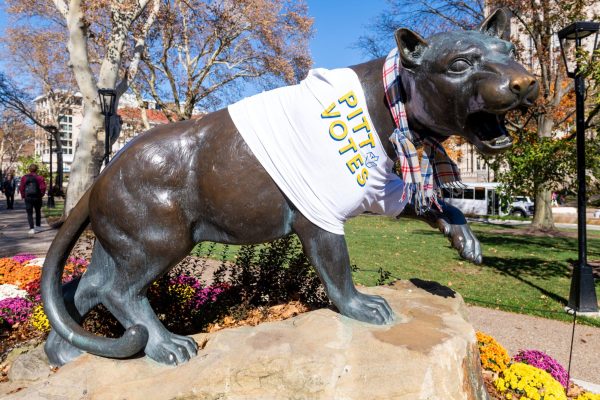Survey says Pitt uses Twitter less than other schools
January 6, 2010
As university students move onto social networking sites like Twitter, so too do the… As university students move onto social networking sites like Twitter, so too do the universities they attend.
The curious thing is, Pitt seems to be moving slower than most American schools.
A report released this fall by UniversitiesAndColleges.org, a site that tracks trends in education, found that Pitt uses Twitter far less frequently than other major American universities.
The report followed the Twitter activities of the nation’s top 100 colleges, as listed in the 2010 U.S. News and World Report Rankings, and ranked Pitt in the bottom 10 for total number of official University Twitter accounts, followers, users following and average Tweets per day.
The site narrowed its scope to include only official university-affiliated accounts. It excluded unofficial student groups, athletic fan pages and any personal accounts of professors, students or faculty members.
Pitt administrators said they weren’t surprised that the University ranked low in the rankings. When the study began in September, the University had just begun its first official Twitter account, PittTweet.
“It is brand-new for us, and this is our first full year of using it,” Pitt spokesman John Fedele said. “It’s still pretty much in the beginning stages. We don’t know how effective it is or what it will be effective at.”
The study found that every top-100 school had at least one official Twitter account, concluding that U.S. universities have been quick to adopt Twitter — a social networking site that is less than 4 years old.
Universities use Twitter as a broadcasting channel, rather than “a medium for conversations,” according to the study, and schools use the site less frequently than average Twitter users.
The study listed Pitt as second-lowest in terms of followers (112 at the time of the study) and third-lowest in both number of users following (28) and average Tweets per day (3.1).
Additionally, it reported that Pitt ranked third-lowest in number of University-affiliated accounts with two, tying with Brown, Clark, the Stevens Institute of Technology and the Colorado School of Mines.
Fedele said he’s not aware of any University-affiliated account other than PittTweet, and UniversitiesAndColleges.org could not be reached for comment.
The problem with the research findings, Fedele said, is a matter of timing.
“We were only up for a couple of days when they conducted the poll,” he said, adding that the first PittTweet was recorded on Aug. 25. Data collection for the study began just days later, on Sept. 1.
Fedele said that for Pitt, Twitter is like any new communications tool, and so it’s still in its exploration phase.
“We’re testing it out. We’re seeing how effective it is,” he said. “If it looks like it’s going to solve some of our communication problems, it will be with us to stay.”
But even four months since its creation, the Twitter account still sees low activity.
As of press time, the site recorded a total of 15 posts, and it had 323 followers. That’s about one-sixtieth of the number of subscribers to the Twitter accounts of the most-followed school, Harvard University.
Topping the list for the university with the most official Twitter accounts was the University of Florida, which recorded 24.
In addition to the main research news outlet, UFNow, and the official campus newsletter, InsideUF, other university affiliates — including the journalism school, the engineering school, the pharmacy school and even the library — are on Twitter.
“We knew some offices were doing it, but we didn’t realize how extensive it was,” university spokesman Steve Orlando said, adding that there was no concerted effort among administrators to begin Twitter accounts.
He said UFNow was originally intended to only reach reporters, but it now attracts students, other universities, local elementary schools and funding agencies. The account broke 1,000 followers last week.
Orlando attributed the number of accounts to the value of social media, adding that Twitter and the university’s Facebook page allow administrators to connect directly with the community.
“It’s no secret that the news business … is going through a real hard time right now,” he said. “There are fewer outlets, there are fewer reporters and our job in the news office is to get news out.”
George Washington University was named the most prolific Twitterer, averaging 57.7 Tweets per day on its 17 accounts.
In addition to posting university-wide news, GW administrators use Twitter for social communications, such as congratulating newly accepted students, soliciting student feedback on course recommendations and networking students with alumni in their respective fields.
Menachem Wecker, electronic communications writer and manager of the university’s main account GWToday, said the decision to move to Twitter-based university broadcasts was an easy one since many students already had accounts.
As a social media expert and co-founder of the Association for Social Media & Higher Education, he predicts that Twitter will slowly gain a foothold among U.S. universities.
“As higher education folks get more used to Twitter, I think we will see more and more people doing things of this sort, because they make sense,” he said in an e-mail. “It’s just tough, I think, because most positions don’t have social media written into their job descriptions.”
Pitt’s low ranking in the UniversitiesAndColleges.org study come as little surprise to Amanda Leff Ritchie, who manages PittTweet.
“If we were placed in the bottom tier for only having nine days of activity, I can understand that,” she said.
While the Twitter account is still gaining speed, Ritchie said she sees more community interaction through Pitt’s official Facebook page, which she also manages.
She said that while Pitt averages at least 10 responses per post on Facebook, she could “count on one hand” the number of responses the Twitter account receives.
“[With Twitter], I feel like I’m talking to a vacuum, but when I’m communicating via Facebook, I feel like there’s really a conversation going on,” Ritchie said.
She recently led a University workshop to promote social networking among Pitt administrators, adding that while PittTweet is the only Pitt Twitter account that she knows, some Pitt departments already have their own Facebook pages.
But with any social media outlet, Ritchie said, Twitter’s effectiveness at Pitt could change.
“Who knows — maybe by this time next year, my opinion will have completely changed,” she said. “But I think right now, Facebook really fits the bill for us to reach out to our students.”







